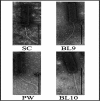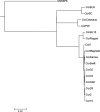Analyses of four new Caulobacter Phicbkviruses indicate independent lineages
- PMID: 30657445
- PMCID: PMC7011694
- DOI: 10.1099/jgv.0.001218
Analyses of four new Caulobacter Phicbkviruses indicate independent lineages
Abstract
Bacteriophages with genomes larger than 200 kbp are considered giant phages, and the giant Phicbkviruses are the most frequently isolated Caulobacter crescentus phages. In this study, we compare six bacteriophage genomes that differ from the genomes of the majority of Phicbkviruses. Four of these genomes are much larger than those of the rest of the Phicbkviruses, with genome sizes that are more than 250 kbp. A comparison of 16 Phicbkvirus genomes identified a 'core genome' of 69 genes that is present in all of these Phicbkvirus genomes, as well as shared accessory genes and genes that are unique for each phage. Most of the core genes are clustered into the regions coding for structural proteins or those involved in DNA replication. A phylogenetic analysis indicated that these 16 CaulobacterPhicbkvirus genomes are related, but they represent four distinct branches of the Phicbkvirus genomic tree with distantly related branches sharing little nucleotide homology. In contrast, pairwise comparisons within each branch of the phylogenetic tree showed that more than 80 % of the entire genome is shared among phages within a group. This conservation of the genomes within each branch indicates that horizontal gene transfer events between the groups are rare. Therefore, the Phicbkvirus genus consists of at least four different phylogenetic branches that are evolving independently from one another. One of these branches contains a 27-gene inversion relative to the other three branches. Also, an analysis of the tRNA genes showed that they are relatively mobile within the Phicbkvirus genus.
Keywords: Bacteriophage; Caulobacter; DNA virus; genomics; pan-genome.
Conflict of interest statement
The authors declare that there are no conflicts of interest.
Figures





Similar articles
-
Identification of proteins associated with two diverse Caulobacter phicbkvirus particles.Arch Virol. 2020 Sep;165(9):1995-2002. doi: 10.1007/s00705-020-04707-2. Epub 2020 Jun 25. Arch Virol. 2020. PMID: 32588241 Free PMC article.
-
New Genera and Species of Caulobacter and Brevundimonas Bacteriophages Provide Insights into Phage Genome Evolution.Viruses. 2024 Apr 20;16(4):641. doi: 10.3390/v16040641. Viruses. 2024. PMID: 38675982 Free PMC article.
-
Genomic Diversity of Type B3 Bacteriophages of Caulobacter crescentus.Curr Microbiol. 2017 Jul;74(7):779-786. doi: 10.1007/s00284-017-1248-4. Epub 2017 Apr 10. Curr Microbiol. 2017. PMID: 28393265 Free PMC article.
-
Bacteriophages and their genomes.Curr Opin Virol. 2011 Oct;1(4):298-303. doi: 10.1016/j.coviro.2011.06.009. Curr Opin Virol. 2011. PMID: 22034588 Free PMC article. Review.
-
Phage diversity, genomics and phylogeny.Nat Rev Microbiol. 2020 Mar;18(3):125-138. doi: 10.1038/s41579-019-0311-5. Epub 2020 Feb 3. Nat Rev Microbiol. 2020. PMID: 32015529 Review.
Cited by
-
Novel Caulobacter bacteriophages illustrate the diversity of the podovirus genus Rauchvirus.Arch Virol. 2020 Nov;165(11):2549-2554. doi: 10.1007/s00705-020-04791-4. Epub 2020 Sep 1. Arch Virol. 2020. PMID: 32870405 Free PMC article.
-
Phage phiKZ-The First of Giants.Viruses. 2021 Jan 20;13(2):149. doi: 10.3390/v13020149. Viruses. 2021. PMID: 33498475 Free PMC article. Review.
-
A flagella-dependent Burkholderia jumbo phage controls rice seedling rot and steers Burkholderia glumae toward reduced virulence in rice seedlings.mBio. 2025 Mar 12;16(3):e0281424. doi: 10.1128/mbio.02814-24. Epub 2025 Jan 27. mBio. 2025. PMID: 39868782 Free PMC article.
-
Recombination and gene loss occur simultaneously during bacterial horizontal gene transfer.PLoS One. 2020 Jan 28;15(1):e0227987. doi: 10.1371/journal.pone.0227987. eCollection 2020. PLoS One. 2020. PMID: 31990919 Free PMC article.
-
Dolichocephalovirinae Phages Exist as Episomal Pseudolysogens Across Diverse Soil Bacteria.Microorganisms. 2025 May 28;13(6):1239. doi: 10.3390/microorganisms13061239. Microorganisms. 2025. PMID: 40572127 Free PMC article.
References
-
- Breitbart M, Rohwer F. Here a virus, there a virus, everywhere the same virus? Trends Microbiol. 2005;13:278–284. - PubMed
Publication types
MeSH terms
Grants and funding
LinkOut - more resources
Full Text Sources

